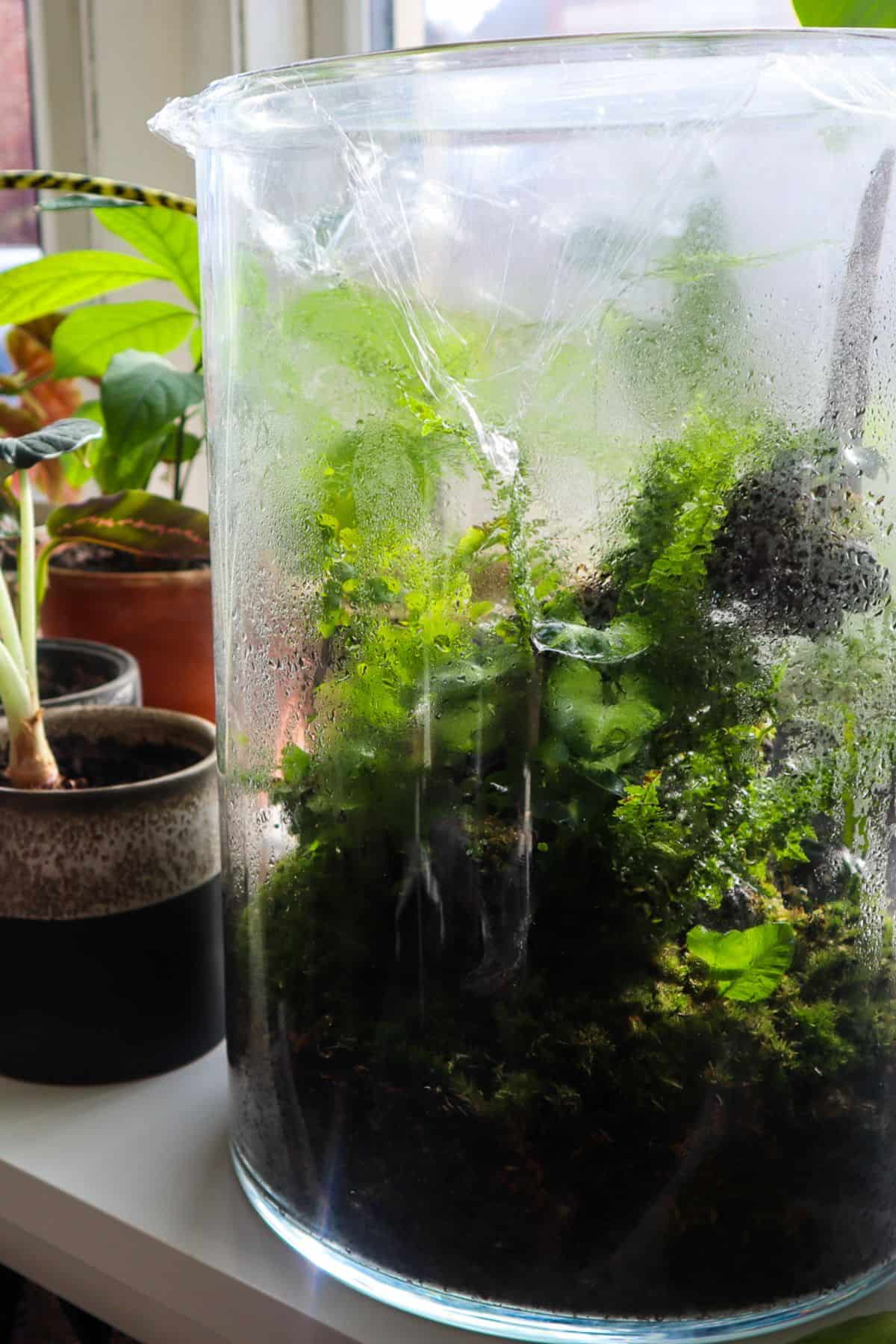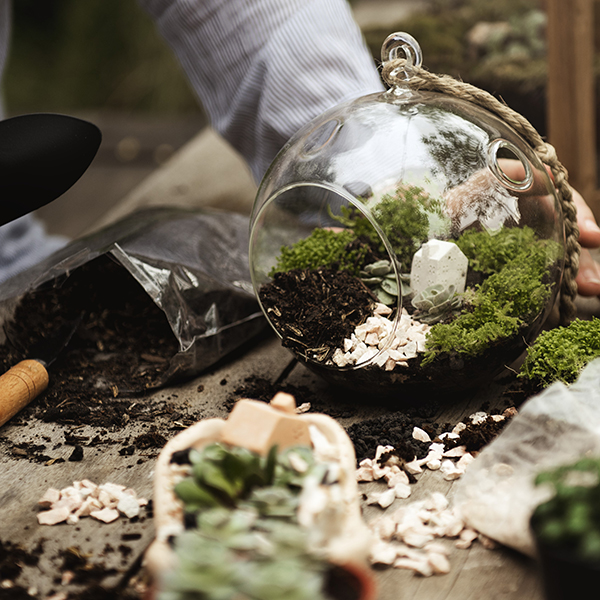To reduce terrarium condensation, increase ventilation and avoid overwatering. Use a hygrometer to monitor humidity levels.
Terrarium condensation can pose problems for plant health and visibility. Excess moisture often leads to mold growth, which can harm plants. Proper ventilation is essential in managing condensation effectively. Small fans or vent holes can promote air circulation, helping to balance humidity.
Avoid overwatering by using a spray bottle to mist plants lightly. Monitoring humidity levels with a hygrometer provides valuable insights. Positioning your terrarium in a location with stable temperature helps prevent sudden moisture build-up. By taking these steps, you can maintain a healthy, clear terrarium environment.
Common Condensation Issues
Condensation in terrariums is a common issue for many enthusiasts. It can affect visibility, plant health, and overall aesthetics. Understanding these problems helps maintain a healthy terrarium environment.
Foggy Glass
Foggy glass is a frequent issue in terrariums. It reduces visibility and can hinder plant growth. Causes include high humidity and poor ventilation.
- High humidity levels
- Poor air circulation
- Inadequate temperature control
To fix foggy glass, try these solutions:
- Improve ventilation by adding small vents.
- Use a dehumidifier to control humidity.
- Adjust the temperature to reduce condensation.
Excess Moisture
Excess moisture can lead to mold and plant diseases. It usually occurs due to overwatering or lack of drainage.
| Cause | Solution |
|---|---|
| Overwatering | Water plants sparingly and check soil moisture. |
| Lack of drainage | Add a layer of pebbles for better drainage. |
Other tips to manage excess moisture include:
- Use a hygrometer to monitor humidity levels.
- Increase light exposure to help dry out the soil.
- Place the terrarium in a well-ventilated area.

Credit: www.reddit.com
Ideal Humidity Levels
Maintaining the ideal humidity levels in your terrarium ensures a thriving environment for your plants and animals. Proper humidity helps prevent mold growth and keeps the ecosystem balanced. This section will guide you through achieving optimal conditions for your terrarium.
Measuring Humidity
To keep your terrarium at the right humidity, you need to measure it. A hygrometer is the best tool for this job. Place the hygrometer inside the terrarium to get an accurate reading.
Here is a simple table showing different types of hygrometers:
| Type | Description |
|---|---|
| Analog | Uses a needle to show humidity levels. |
| Digital | Displays humidity on a screen. More accurate. |
| Wireless | Can be monitored remotely with an app. |
Optimal Ranges
Different plants and animals need different humidity levels. Here are some optimal ranges:
- Tropical Plants: 70%-90%
- Desert Plants: 20%-30%
- Amphibians: 60%-80%
- Reptiles: 40%-60%
Monitor the humidity daily to ensure it stays within these ranges. If it’s too high or too low, make adjustments.
Use a spray bottle to increase humidity. For reducing it, improve ventilation or use a dehumidifier.
Ventilation Techniques
Effective ventilation is crucial for managing terrarium condensation. Proper airflow helps maintain humidity levels and prevents mold growth. This section delves into various ventilation techniques to optimize your terrarium environment.
Types Of Vents
Choosing the right vent type is essential. Different vents serve different purposes. Here are some common options:
- Screen Vents: Ideal for small terrariums. They allow air to circulate while keeping pests out.
- Adjustable Vents: Provide control over airflow. You can open or close them as needed.
- Fan-Assisted Vents: Suitable for larger setups. They actively move air to regulate humidity.
Placement Strategies
Where you place your vents can impact their effectiveness. Strategic placement ensures optimal airflow. Consider these tips:
- Top Vents: Place vents at the top for heat and moisture escape. This helps reduce condensation.
- Side Vents: Use side vents for cross ventilation. This encourages fresh air flow.
- Bottom Vents: Position bottom vents for cool air intake. This works well with top vents for a balanced system.
Using the right ventilation techniques can make a significant difference. Proper vent types and strategic placement ensure a healthy terrarium environment.
Choosing The Right Plants
Selecting the best plants for your terrarium is crucial. The right plants help manage condensation and ensure a healthy environment. Let’s explore the best plants for a humid terrarium and how to arrange them.
Humidity-tolerant Species
Certain plants thrive in humid environments. These are ideal for terrariums with condensation issues. Here are some excellent choices:
- Mosses – They love moisture and help absorb excess water.
- Ferns – Ferns thrive in high humidity and add lush greenery.
- Peperomia – These plants are low-maintenance and enjoy humid conditions.
- Fittonia – Known as nerve plants, they flourish in damp settings.
Plant Arrangement
Arranging plants correctly ensures a balanced ecosystem. Here’s a simple guide to arranging your terrarium plants:
- Place larger plants at the back. This creates depth and visual interest.
- Position smaller plants at the front. This allows them to get enough light.
- Mix different textures. Combine leafy plants with mosses for variety.
- Ensure air circulation. Leave small gaps between plants to prevent mold.
Using a proper arrangement helps manage condensation effectively. Follow these steps for a thriving terrarium.
Substrate Selection
Selecting the right substrate for your terrarium is crucial. The substrate impacts condensation, plant health, and overall ecosystem balance. With the right materials and layering techniques, you can create a thriving terrarium environment. Let’s explore how to choose the best substrate for your needs.
Absorbent Materials
Using absorbent materials helps manage moisture levels in your terrarium. Good choices include moss, coco coir, and peat. These materials soak up excess water and reduce condensation. Absorbent substrates also provide a stable environment for plant roots. They prevent the build-up of stagnant water, which can lead to root rot.
| Material | Benefits |
|---|---|
| Moss | High moisture retention, natural appearance |
| Coco Coir | Good drainage, eco-friendly |
| Peat | Retains moisture, supports plant growth |
Layering Tips
Proper layering is essential for terrarium health. Start with a drainage layer at the bottom. This can be gravel or small rocks. Next, add a layer of activated charcoal. Charcoal keeps the terrarium fresh by absorbing toxins. Finally, add the main substrate layer on top. This can be a mix of soil and absorbent materials.
- Drainage Layer: Gravel or small rocks
- Activated Charcoal Layer
- Main Substrate Layer: Soil and absorbent materials
Ensure each layer is even and compact. This prevents air pockets and uneven water distribution. An effective substrate setup minimizes condensation and promotes healthy plant growth.

Credit: terrariumtribe.com
Lighting Considerations
Lighting is crucial for maintaining the right conditions in a terrarium. It affects both plant growth and humidity levels. Proper lighting can help manage condensation, keeping your terrarium healthy.
Light Intensity
Light intensity plays a key role in terrarium health. Too much light can cause overheating, leading to excess condensation. On the other hand, too little light can stunt plant growth and lead to mold.
Finding the right balance is essential. Use a light meter to check the intensity. Adjust the distance between the light source and the terrarium. Plants like ferns and mosses need low to medium light. Succulents and cacti prefer bright light.
Heat Emission
Another factor to consider is heat emission. Lights can generate heat, affecting the terrarium’s temperature and humidity. High heat levels can increase condensation, creating a humid environment.
Choose low-heat emitting lights like LED or fluorescent bulbs. These lights provide adequate illumination without raising the temperature. Positioning the light outside the terrarium can also help control heat.
Here’s a table summarizing the heat emission of different light types:
| Light Type | Heat Emission | Recommended Use |
|---|---|---|
| LED | Low | Most Terrariums |
| Fluorescent | Moderate | Medium to Large Terrariums |
| Incandescent | High | Avoid |
To summarize, lighting impacts both the growth and health of your terrarium plants. Proper light intensity and heat management help prevent excess condensation. This ensures a balanced and thriving ecosystem.
Watering Practices
Proper watering practices are crucial for maintaining a healthy terrarium. Ensuring the right frequency and amount of water can prevent condensation issues. These practices will help keep your terrarium in optimal condition.
Frequency
Watering your terrarium at the right frequency is essential. Over-watering can lead to excess condensation, while under-watering can dry out plants.
- Check the soil moisture every few days.
- Water only when the top layer of soil feels dry.
- Avoid watering if there is visible condensation.
Amount
The amount of water you use is just as important as the frequency. Too much water can create a swampy environment, which can harm plants.
- Use a spray bottle for controlled watering.
- Spray lightly until the soil feels damp.
- Avoid soaking the soil to prevent waterlogging.
| Watering Tool | Recommended Use |
|---|---|
| Spray Bottle | Light, even moisture |
| Dropper | Precise watering |
Monitoring And Maintenance
Ensuring a healthy terrarium requires regular monitoring and maintenance. Too much or too little condensation can harm your plants. This section covers essential checks and adjustments for an optimal environment.
Routine Checks
Performing routine checks helps keep your terrarium balanced.
- Check condensation levels daily.
- Inspect plant health and growth.
- Ensure soil moisture is adequate.
Use a hygrometer to measure humidity levels accurately. Keep a log to track changes over time.
Adjustments
Sometimes, you need to make adjustments to maintain balance.
- Ventilation: Open the lid slightly to reduce excess moisture.
- Watering: Add water if the soil is too dry.
- Lighting: Adjust light exposure to prevent mold growth.
Make small changes and observe the effects. This ensures you do not shock the ecosystem.

Credit: www.westonnurseries.com
Conclusion
Solving terrarium condensation issues ensures a healthy environment for your plants. Regular monitoring and proper ventilation are key. Use these simple solutions to maintain optimal humidity levels. Keep your terrarium thriving by addressing condensation effectively. Happy gardening and enjoy the beauty of your crystal-clear terrarium!
